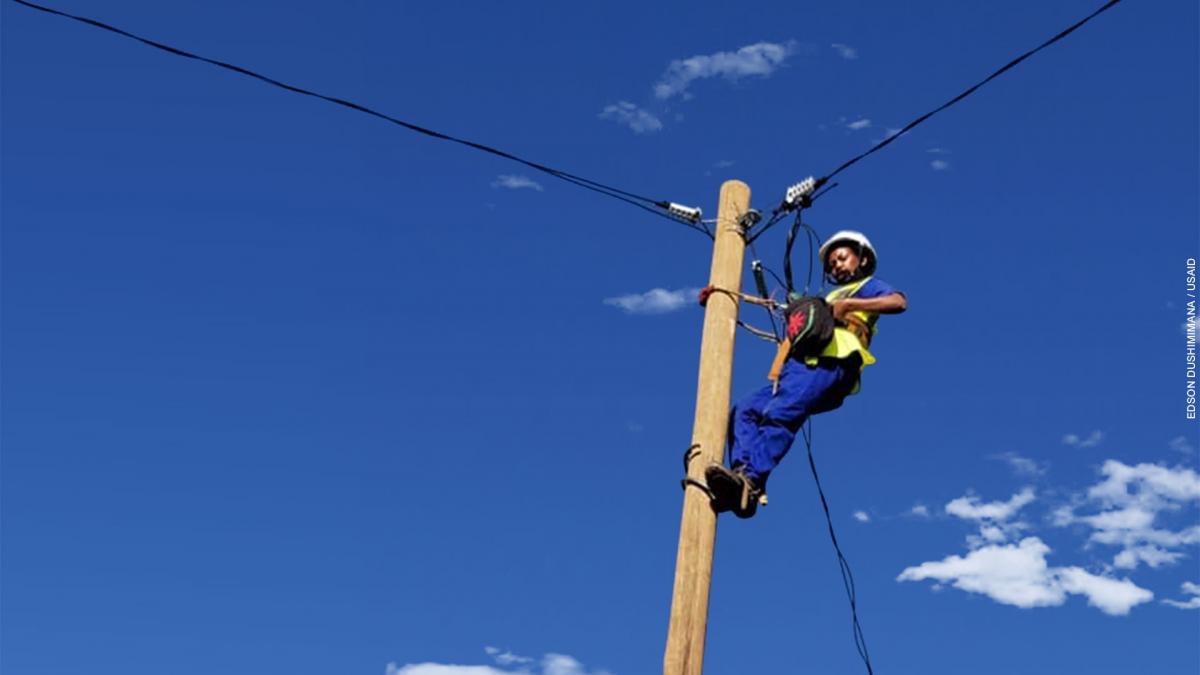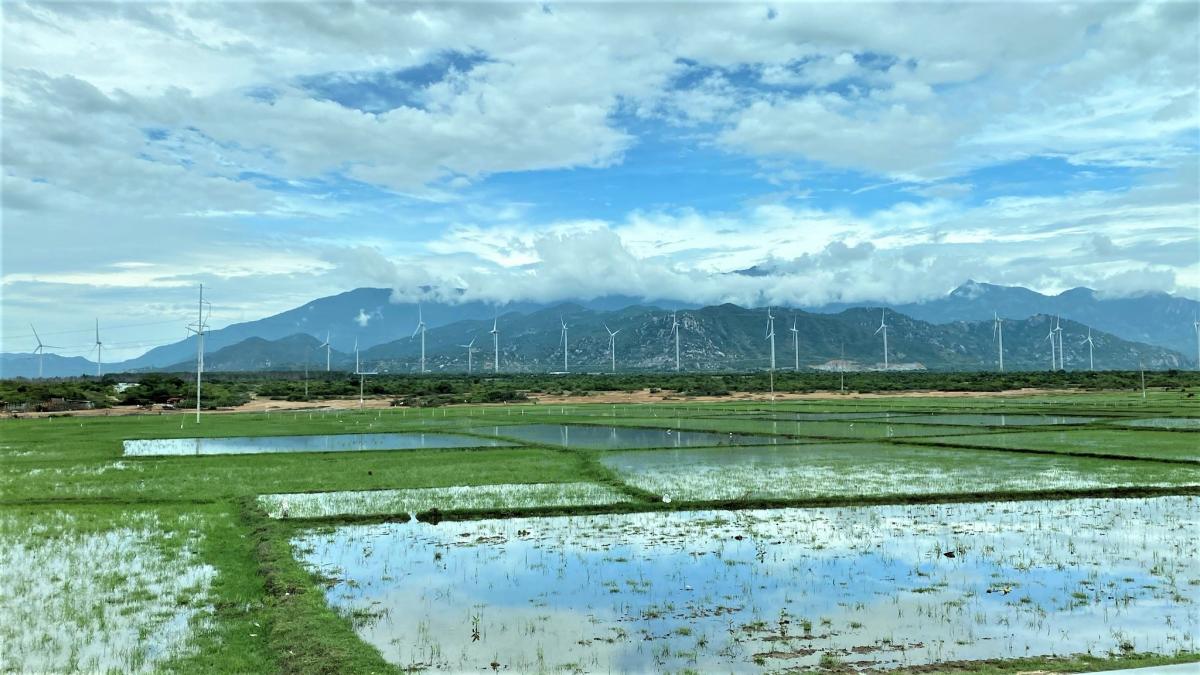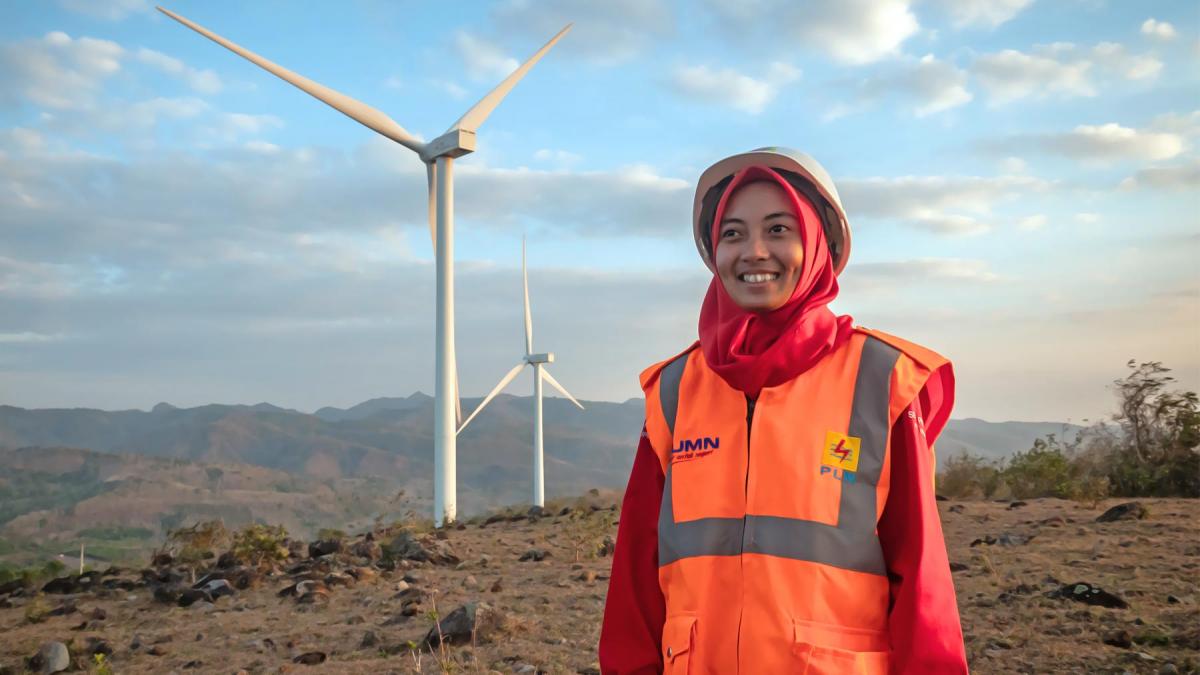Style
With the urgency of the climate crisis coupled with the volatility of geopolitics, USAID is using its programs to drive the clean energy transformation and ensure that our partner countries have access to secure, affordable, and sustainable energy.
In this year’s Energy Sector Photo Contest, we received 122 photos that represent this work across 29 USAID programs and projects in 28 different countries. These winning photographs tell the story of USAID’s energy programming across a variety of sectors, such as gender, energy access, infrastructure, climate, and power sector reform. Read on to see our overall winners and winners for individual categories. Congratulations to our winners and to all participants!
1st Place Overall: USAID/Ukraine
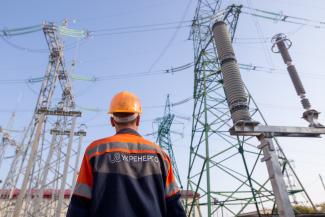
On March 16, 2022, just weeks after Russian troops and tanks poured across the border in a full-scale invasion, Ukraine successfully connected its electricity grid to that of the European Union. This critical step, the result of years of incredible efforts by Ukrainian electricity system operators backed by long-term USAID support, bolstered Ukraine’s energy security in its time of greatest need.
In response to Russia’s strikes on energy infrastructure, USAID is investing $475 million to help Ukraine repair and maintain its power and heating systems, delivering transformers, heating pipes, circuit breakers, and much more to keep power and heat flowing to millions of Ukrainians.
At the same time, USAID has continued to help Ukraine strengthen its connections with Europe, supporting the country’s long-term energy security and advancing Ukraine’s integration with the European Union. While Russia continues to target civilian energy facilities, Ukraine’s energy workers embody the resilience that has allowed Ukraine to defend itself against Russia’s unjustified war.
Photo Credit: Vlad Sodel / USAID Ukraine
Location: Kyiv, Ukraine
2nd Place Overall: Power Africa
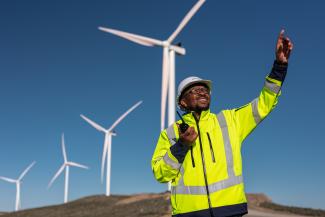
USAID and Power Africa’s support to the Karusa and Soetwater wind farms, located about three hours by car from Cape Town in South Africa’s Northern Cape Province, began before they were built. They were awarded to Power Africa partner Enel Green Power as part of the fourth bidding window of South Africa's Renewable Energy Independent Power Producer Procurement Programme (REIPPPP). USAID/Power Africa supported the advancement of 27 of these renewable energy projects under this bid window to reach financial close. Karusa and Soetwater, which both came online in 2022, now sell clean electricity to South Africa’s public electricity utility, Eskom, under a 20-year power purchase agreement.
Between the two wind farms, over 70 gentle giant wind turbines hug the country’s Karoo landscape. The turbines are the largest in Africa and were manufactured by another Power Africa partner, Vestas. Each turbine generates 4.2 megawatts of power, totalling 1.1 terawatt hours of renewable energy annually between the two farms. This translates into averting 1 million tons of CO2 emissions per year.
Israel Thothela, pictured here at Karusa, is Enel’s Plant Operations & Maintenance Manager at the two farms and explains why South Africa needs more clean energy like this: “As a country, we need more and more of clean energy that is being produced and supplied into the national grid that will also alleviate poverty and create employment in the communities where we have these natural resources.”
Photo Credit: Fraser Schenck / Power Africa
Location: Laingsburg, Western Cape, South Africa
3rd Place Overall: USAID Southeast Asia Smart Power Program (SPP)
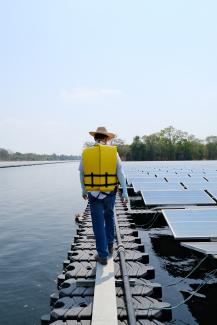
Walking carefully on a floating path across the lake surface of SCG Floating Solar in Saraburi Province, Thailand, Theerasak Karunuthaisiri, a Solar Operation and Maintenance Supervisor, explained that this floating photovoltaics (FPV) farm can generate up to 25.8 megawatts (MW) of electricity.
During a visit, the USAID SPP team learned that the floating solar panels could last longer than 25 years and, since they are made from High-Density Polyethylene (HDPE) food-grade plastic, these systems are safe for the aquatic ecosystem in this area.
Floating solar is an emerging technology with surging interest in Southeast Asia. As USAID’s initiative in blended financing over the next five years for clean energy infrastructure, with a commitment to reducing greenhouse gas emissions and achieving global net-zero emissions across the region by 2050, SPP has ambitious goals and hopes to help mobilize financing for more than 2 gigawatts (GW) from renewable energy such as this project.
Photo credit: Watchareeya Yodprathum / USAID SPP
Location: Saraburi Province, Thailand
Category Winners
Climate and Energy: Power Africa
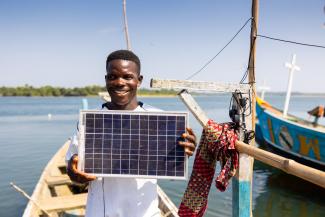
Power Africa, through USAID, awarded grants totaling $669,330 to five solar energy companies operating in Liberia. This funding will assist the grantees to distribute solar-powered productive use of energy (PUE) technologies that let users harvest, process, and preserve agricultural produce and fish, or power small businesses. One of the grantees, Liberian Energy Network Two (LEN), has been scaling its solar-powered fishing light pilot project in Robertsport, Cape Mount County, by supplying fishing communities with multi-pronged fishing lights and communal cold storage powered by mobile solar panels.
Photo Credit: Fraser Schenck / Power Africa
Location: Marshall, Liberia
Energy Effiency: Energy Empowers East Africa
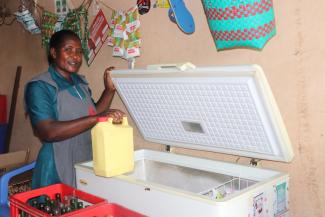
A woman in her business in Uganda learns to read efficiency labels and understand electricity consumption in chest freezers. USAID, in collaboration with Lawrence Berkeley National Laboratory, implements the Energy Empowers East Africa Program to increase the inclusion of women in electrification programs throughout East Africa. The objective is to identify key actions that will unlock the benefits of modern energy access for women and enhance their role as agents of change in promoting clean, affordable, and efficient energy use.
The program focuses on increasing opportunities for efficient and productive use of energy through community based participatory surveys, educational materials on equipment’s productive use and energy efficiency, entrepreneurial skill development, access to markets for efficient products, awareness campaign, financing, and creation of women’s self-help networks.
Photo Credit: USAID/LBNL Energy Empowers East Africa Program
Location: Uganda
Equitable Energy Access: Feed the Future Sénégal Nafoore Warsaaji
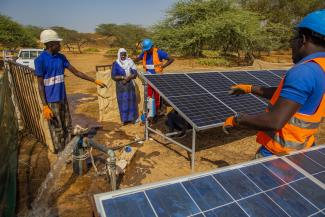
A member of The Agricultural Cooperative Society of Women Producers of Potou GUEYE (SOCOPA-FPPG) in the region of Louga in Senegal inspects a newly acquired sprinkler irrigation system. Through the technical assistance and intermediation of Nafoore Warsaaji, the cooperative provides its members with quality seeds and fertilizers, and promotes access to irrigation and solar pumping technologies.
Within the framework of the voucher program for solar pumping kits, Nafoore Warsaaji granted a subsidy of 21,109,500 FCFA to the female members of the cooperative for the installation of 111 solar pumping kits and rehabilitated the community farm of 3 hectares.
Photo Credit: Assane Thiam / Feed the Future Sénégal Nafoore Warsaaji
Location: Leona, Louga Region, Sénégal
Energy Infrastructure: Community Support Program
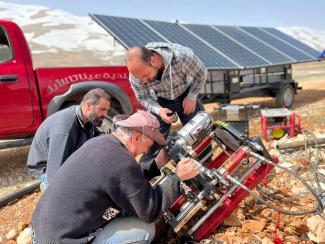
Lebanon is experiencing a severe economic crisis, exacerbated by the impact of the COVID-19 pandemic and Russia’s invasion of Ukraine. Fuel and energy costs are becoming unaffordable, which is severely affecting the delivery of essential services. As a result, more and more Lebanese entities are turning to renewable energy solutions to counter the collapse of essential services. Ainata el Arz is an agricultural village in the Bekaa, home to around 2,780 Lebanese residents and 350 Syrian refugees. Located at an altitude of 1,500 meters, it faces harsh weather conditions, which threatens crops and places significance on timely pruning and cultivation.
In response, USAID’s Community Support Program (CSP) provided the community with a solar-powered mobile welding machine to enable the 720 concerned farmers to improve and repair irrigation lines more efficiently. USAID’s support also strengthened farmer capacity to do maintenance locally without having to drive long distances to the nearest repair shop.
Photo Credit: Fadi Attieh / USAID CSP
Location: Ainata, Bekaa, Lebanon
Energy Security: Small and Medium Enterprise Assistance for Recovery and Transition (SMART) Project
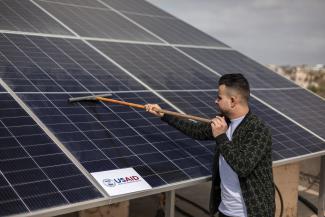
Staff clean and maintain the newly installed rooftop solar panels at Baby Center Company, a small Gazan garments manufacturer. With power cuts for up to 16 hours per day, alternative energy is often the only option for Gazan businesses. As the owner of Baby Center Company, Sulaiman Deeb knew he needed reliable electricity when he reopened his business in the wake of COVID-19.
In 2022, the USAID SMART Project awarded Baby Center a cost-shared Recovery Plan to fund the replacement of old, inefficient sewing machines, as well as an upgrade to the factory’s rooftop solar and inverter system to increase output and reduce noise pollution. No longer limited to the 8 hours of grid power, Sulaiman added a second shift and hired and trained 30 new employees, 20 of whom are women. Sales have since increased by 297 percent.
Photo Credit: Moumen Al Raiees / USAID SMART Project
Location: Khan Younis, Gaza
Gender Equality and Women's Empowerment: Engendering Industries
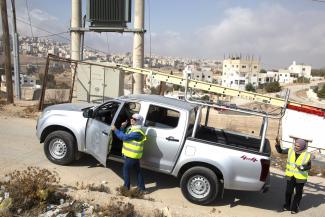
Rania Shamayla, Head of Subscribers Department at Electricity Distribution Company (EDCO), steps out of a truck to check a transformer in Kerak, Jordan. Shamayla became the first female officer to be elected to Jordan’s electrical workers union in 2022, tapping into a network of both women and men at EDCO to secure enough votes. EDCO has partnered with Engendering Industries since 2015 to improve gender equality and has focused on creating networking opportunities for women at the company, which facilitated Shamayla’s election.
Photo Credit: Alec Jacobson / USAID Engendering Industries Program
Location: Kerak, Jordan
Just Transition: Scaling Up Renewable Energy
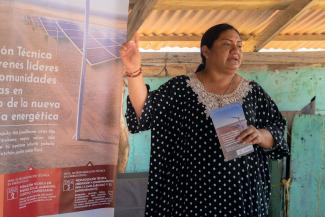
The clean energy transition significantly impacts workers, women, rural communities, Indigenous lands, and marginalized groups that have traditionally been less likely to be consulted and informed on projects or to have their voices heard. USAID’s Scaling Up Renewable Energy program works with the Government of Colombia’s National Training Service to provide young people in Indigenous Wayúu communities with vocational training and opportunities to work in the renewable energy economy.
USAID supports Colombia’s just and inclusive energy transition by empowering Indigenous Populations with new opportunities for a better future.
Photo Credit: Walter Consuegra / USAID SURE Program
Location: Colombia
Reliable Energy: Community Support Program
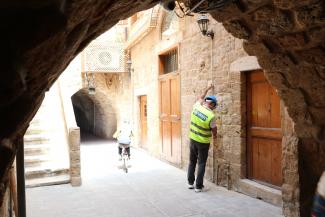
The historical streets of Old Saida gleam under the warm light of 48 solar-powered LED streetlights thanks to USAID’s Community Support Program (CSP). With brighter paths and safer access to public spaces, the area's rich cultural heritage is showcased to an estimated 7,000 residents and tourists alike. Old Saida's charm lies in its winding alleys and centuries-old architecture, but inadequate lighting made it difficult to appreciate its beauty after dark.
USAID’s intervention has breathed new life into the area, attracting visitors once again to wander the charming streets and discover the hidden gems nestled within. Today, Old Saida shines bright and is ready to welcome visitors once again with open arms and illuminated streets.
Photo Credit: Nada Hamze / USAID CSP
Location: Old Saida, South Lebanon
Renewable Energy: Vietnam Low Emission Energy Program II (V-LEEP II)
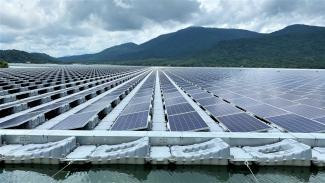
Dami Floating Solar Farm in Binh Thuan Province, Vietnam. Đa Mi floating solar is the first floating solar plant in Vietnam with a capacity of 47.5MWp. Da Mi floating solar plant is located in La Ngau commune (Tanh Linh district) and Da Mi and La Da communes (Ham Thuan Bac district), Binh Thuan province.
Photo Credit: USAID V-LEEP II
Location: Binh Thuan Province, Vietnam
Sector Governance and Reform: Papua New Guinea Electrification Partnership (PEP)
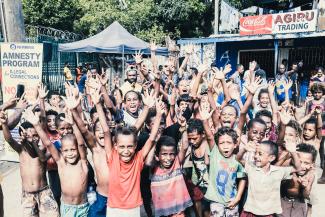
USAID-PEP, in partnership with the PNG Power Limited held an Amnesty Initiative for illegal electricity connection in the Koki settlement in Port Moresby, Papua New Guinea. The campaign engaged with illegal electricity consumers and registered them in the official utility customer list.
Photo Credit: Mamuka Kikalishvili / USAID-PEP Activity
Location: Koki Settlement, Port Moresby, Papua New Guinea
Transportation: Power Africa Off-Grid Project
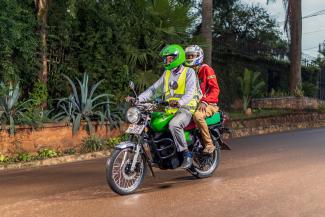
The first boda-boda (motorcycle-taxi) drivers for Zembo are proud to be part of the African e-mobility revolution. They are the bearers of Zembo's vision; they trusted and believed in the new wave of e-mobility, and from these very drivers, Zembo came to light. Today, more than 200 drivers picked interest in the eco-friendly electric powered motorcycles that earned them more savings in their pockets. "I am saving more, because of this electric bike," says one driver.
Thanks to this support from Power Africa’s Off-grid Project, Zembo saved 250 tons of carbon emissions last year and improved the working and living conditions of its clients.
Zembo assembles and sells electric motorcycles on a rent-to-own model to lower-income motorcycle-taxi drivers. The company operates a network of hybrid recharge stations across Kampala, where drivers can swap their batteries and pay for the energy used. Solar recharge stations allow Zembo to charge batteries in off-grid areas and during grid blackout.
Photo Credit: Etienne Saint-Sernin / Zembo Motorcycle SMC LTD
Location: Ntinda, Uganda

